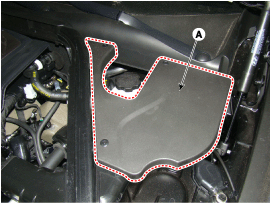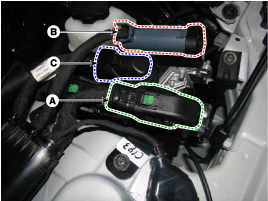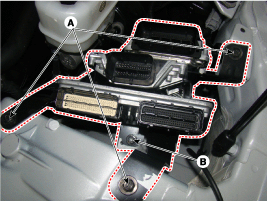Hyundai Genesis: Automatic Transmission Control System / Transmission Control Module (TCM) Repair procedures
Hyundai Genesis (DH) 2013-2016 Service Manual / Automatic Transmission System (SBC) / Automatic Transmission Control System / Transmission Control Module (TCM) Repair procedures
| Removal |
| 1. |
Turn ignition switch OFF and disconnect the negative (-) battery cable. |
| 2. |
Remove the cover (A).
|
| 3. |
Disconnect the ECM connector (A), TCM connector (B) and IDB connector (C).
|
| 4. |
Remove the TCM & ECM & IDB after removing the bolts (A) and nut (B).
|
| 5. |
Remove the TCM (B) after removing the nuts (A).
|
| Installation |
| 1. |
Install in the reverse order of removal.
|
| Inspection |
| TCM Problem Inspection Procedure |
| 1. |
TEST TCM GROUND CIRCUIT: Measure resistance between TCM and
chassis ground using the backside of TCM harness connector as TCM side
check point. If the problem is found, repair it.
|
| 2. |
TEST TCM CONNECTOR: Disconnect the TCM connector and visually
check the ground terminals on TCM side and harness side for bent pins
or poor contact pressure. If the problem is found, repair it. |
| 3. |
If any problems are not found in Step 1 and 2, the TCM could
be faulty. If so, make sure there are no DTCs before replacing the TCM
with a new one, and then check the vehicle again. If DTCs are found,
examine this first before replacing TCM. |
| 4. |
RE-TEST THE ORIGINAL TCM: Install the original TCM (with
possible fault) into a known-good vehicle and check the vehicle. If the
problem occurs again, replace the original TCM with a new one. If
problem does not occur, this is an intermittent problem (Refer to
“Intermittent Problem Inspection Procedure” in Basic Inspection
Procedure). |
 Transmission Control Module (TCM) Schematic Diagrams
Transmission Control Module (TCM) Schematic Diagrams
1. TCM Connector and Terminal Function
2. TCM Terminal Function
Connector
PinDescriptionPinDescription1Battery power48-2Battery power49-3Power(IG 1)5027 Brake control solenoid valve4Ground51-5G ...
 Transmission Oil Temperature Sensor Description and Operation
Transmission Oil Temperature Sensor Description and Operation
Description
Transmission oil temperature sensor monitors the automatic Transmission fluid's temperature and conveys the readings to TCM.
It is an NTC (Negative Thermal Coefficient) sensor whose ...
Other information:
Hyundai Genesis (DH) 2013-2016 Service Manual: Rear Oil Seal Components and Components Location
Components 1. Rear oil seal2. Rear oil seal case ...
Hyundai Genesis (DH) 2013-2016 Service Manual: Timing Chain Repair procedures
Removal 1. Set No.1 cylinder to top dead center (TDC)/compression. (1) Turn the crankshaft pulley clockwise and align its groove with the timing mark "T" of the lower timing chain cover. (2) Check that the mark (A) of the camshaft timing sprockets is in the straight line on the cylinder ...
© 2013-2025 www.hgenesisdh.com






